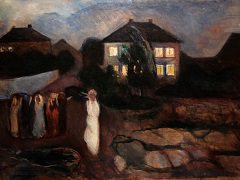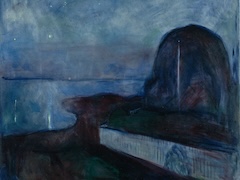Winter, 1899 by Edvard Munch

Landscape was an important genre for Munch. In the years around the turn of the century, he created a number of landscapes with winter motifs from Nordstrand just outside the capital. In the painting Winter we find ourselves gazing into a dark spruce forest illuminated by light reflected from the snow-covered earth. Although there are no people here, we see traces in the snow, where some lonely traveller has passed along the path in the foreground. The mood is heavy with silence and meditative calm.
The picture is sketchily painted. We see how the brush has swept over the snow-covered trees in quick, gentle arcs. In many places the underlying brown cardboard is visible through the thin layer of oil paint. The picture's fine balance between straight and curved lines, dark and light areas, between flat expanses and perspective effects is typical of Munch's landscape art. Through the simplification of form and the play of line he draws attention to the picture surface. At the same time, the sloping line of the path, the rapidly diminishing height of the trees and the subtle light effects all establish the forest as a space.
The picture is sketchily painted. We see how the brush has swept over the snow-covered trees in quick, gentle arcs. In many places the underlying brown cardboard is visible through the thin layer of oil paint. The picture's fine balance between straight and curved lines, dark and light areas, between flat expanses and perspective effects is typical of Munch's landscape art. Through the simplification of form and the play of line he draws attention to the picture surface. At the same time, the sloping line of the path, the rapidly diminishing height of the trees and the subtle light effects all establish the forest as a space.




















